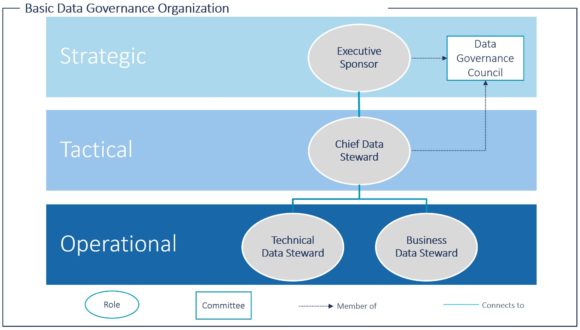Data governance is one of the top trends in Data, BI & Analytics according to a study published by BARC , and many companies are increasingly recognizing the importance of a data-driven approach. But data governance is no “one time project”, no quick fix, and certainly no “one size fits all”. It is rather a continuous discipline, tailored to fit the context of your business to leverage the full potential of your data.
Becoming a data-driven company is a strategic goal for many businesses and it is almost mandatory to stay competitive no matter the business model or size of the company. One key aspect for this purpose is the establishment of a data governance organization, respectively organizational structures dedicated to managing data as a crucial company asset. An effective data governance however needs to be developed considering the unique context of the business. How is a suitable governance developed? This article gives you an overview on what needs to be considered when designing a data governance organization to serve within the context of your organization without blowing the concept out of proportion.
Components of Data Governance Frameworks
Data Governance Frameworks are usually comprised as a toolbox to support building a sustainable organizational structure with different elements and aspects. These different elements are reflected in dimensions such as strategy, processes, roles and responsibilities, technologies, and general principles related to dealing with data.
While some frameworks are very detailed, others just give a rough indication of what is supposed to happen on the road to a sustainable governance. But the core message should always be: “Data Governance is not a ‘one size fits all’!”. Especially when it comes to organizational aspects, roles, and responsibilities respectively, there are as many unique approaches to data governance as there are business models.
This is where the data contingency model comes in. The model, designed by scientists of the University St. Gallen, suggests that factors like performance strategy, diversification breadth, organization structure, competitive strategy, degree of process harmonization, degree of market regulation, and decision-making style have an influence on data and should therefore be considered when designing a data governance organization specific to an organization.
Configurations According to the Contingency Approach
A well-designed data governance organization usually comprises all three levels of an organization: strategic, tactical, and operational. So, the basic template for a governance organization usually looks similar to this:

Using the contingency approach, it is possible to adjust this basic template according to the organizational phenotype. Let’s take diversification breadth as an example, which is a factor that relates to market as well as product diversification. A high diversification means higher complexity in product and customer data. With regards to our data governance model this means that we need to add some roles to consider this complexity. The technical data steward as well as the business data steward are moved to the tactical level and are being supported by a coordinating data steward. The reason behind this is that there are multiple data stewards representing different markets or product groups. The chief data steward moves more toward the strategic level. On the operational level there are multiple teams of operational data stewards as well as data custodians and user groups that represent local specifics, especially in a highly diverse market situation. The organization, that could be present in a very diverse context, can be seen below.

Another interesting example are cultural factors or the decision-making style, which ranges from individual authorities taking decisions centrally to a consensus-based decision approach, led by teams. The classic data governance organization represents a rather individualized approach. Decisions are taken centrally, usually by the chief data steward or the data governance council, which is mainly comprised of higher-level senior managers. A team-based decision-making approach requires coordinating roles, which help find consensus between different teams. Decisions are not taken by individuals but by larger councils and communities, where consensus is in focus. One phenotype of a team-based data governance organization could look like this:

These are only two very illustrative examples of how contingency factors could be considered in developing a governance that serves the organizations, not the other way around. They already illustrate: It really does depend! It needs to be highlighted that the different factors are to be seen as a spectrum. However, they give a great guideline in assessing your data governance organization and maybe find the adjustments that make it suit your needs.
If you want to hear more about techniques to help you develop a suitable data governance organization or if you maybe even want support in designing and setting it up in your company, please don’t hesitate to reach out to our experts at CAMELOT!

